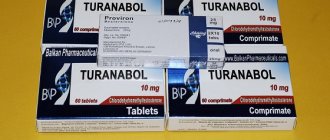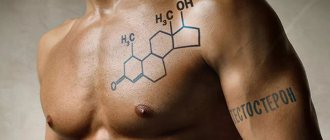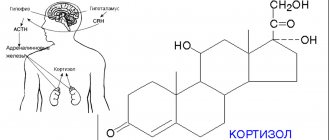Fitness and bodybuilding Anatomy
There is no doubt that bodybuilding has a positive effect on the health of the human body. With the help of strength training and a proper diet, we strengthen the heart and blood vessels, increase immunity, control body weight and speed up thought processes. However, there is another aspect that we often forget about - the close connection of the training process with the endocrine glands.
Endocrine system
(from the Greek words “endo” - internal, and “krine” - to secrete or secrete) is represented by a class of chemical compounds that we used to call hormones. Invisible molecules play the role of messengers and transmit information from the endocrine glands to the internal organs, controlling many physiological processes. Of course, for the “hormonal” control of our body to be truly effective, strict control over the secretion of the hormones themselves is necessary.
The training process is an excellent tool that allows us to arbitrarily change the secretion of biologically active substances and the susceptibility of organs and tissues to the action of chemical messengers. Clinical trials have proven that exercise not only affects the level of hormones circulating in the blood, but also increases the number of receptors in target organs and increases their sensitivity to mediators.
In this article, we will talk about how the endocrine system controls our lives, and how playing sports affects its work. We will get acquainted with key hormones and the most important endocrine glands, and also find the thin thread that connects them with the training process.
Endocrine system
The endocrine glands synthesize and secrete hormones that, in close cooperation with the nervous and immune systems, influence internal organs and control their functional state, managing vital functions. Biologically active substances are released directly into the blood, the circulatory system carries them throughout the body and delivers them to those organs and tissues whose work depends on these hormones.
Specific membrane structures (hormone receptors) on the surface of cells and target organs have an affinity for certain hormones and snatch them from the bloodstream, allowing the messengers to selectively penetrate only the desired tissues (the system operates on the principle of a key and lock). Once at their destination, hormones realize their potential and radically change the direction of metabolic processes in cells.
Considering the almost unlimited capabilities of the endocrine control system, it is difficult to overestimate the importance of maintaining hormonal homeostasis. The secretion of many hormones is regulated by a negative feedback mechanism, which allows you to quickly switch between increasing and decreasing the production of biologically active substances. Increased secretion of the hormone leads to an increase in its concentration in the bloodstream, which, according to the feedback principle, inhibits its synthesis. Without such a mechanism, the work of the endocrine system would be impossible.
Main endocrine glands:
- Thyroid
- Parathyroid glands
- Adrenal glands
- Pituitary
- Pineal gland
- Pancreas
- Gonads (testes and ovaries)
In our body there are organs that are not endocrine glands, but at the same time secrete biologically active substances and have endocrine activity:
- Hypothalamus
- Thymus gland, or thymus
- Stomach
- Heart
- Small intestine
- Placenta
Despite the fact that the endocrine glands are scattered throughout the body and perform various functions, they are a single system, their functions are closely intertwined, and their influence on physiological processes is realized through similar mechanisms.
Three classes of hormones (classification of hormones by chemical structure)
- Amino acid derivatives
. From the name of the class it follows that these hormones are formed as a result of modification of the structure of amino acid molecules, in particular tyrosine. An example is adrenaline. - Steroids
. Prostaglandins, corticosteroids and sex hormones. From a chemical point of view, they belong to lipids; they are synthesized as a result of complex transformations of the cholesterol molecule. - Peptide hormones
. In the human body, this group of hormones is most widely represented. Peptides are short chains of amino acids; an example of a peptide hormone is insulin.
It is curious that almost all the hormones in our body are protein molecules or their derivatives. The exception is sex hormones and adrenal hormones, which are classified as steroids. It should be noted that the mechanism of action of steroids is realized through receptors located inside cells; this process is long and requires the synthesis of protein molecules. But hormones of a protein nature immediately interact with membrane receptors on the surface of cells, due to which their action is realized much faster.
The most important hormones whose secretion is affected by exercise:
- Testosterone
- A growth hormone
- Estrogens
- Thyroxine
- Insulin
- Adrenalin
- Endorphins
- Glucagon
↑ Symptoms of stress
The effect of stress on hormones is a proven fact. An acute reaction begins a few minutes after interaction with the provoking factor. Symptoms include the following:
- The person becomes disoriented; he seems to distance himself from what happened, but at the same time he is able to pay attention to details. He is characterized by inexplicable actions, devoid of meaning. It often seems to others that he has gone crazy.
- The expression of delusional ideas is noted. A person begins to talk about events and people that cannot exist in reality. This phenomenon can last for a few minutes, after which it ends abruptly.
- When contacting a person, he may not react in any way. It is common to ignore requests or to carry them out incorrectly.
- There is inhibition, both speech and motor. It can manifest itself so strongly that a person gives answers to questions in the form of a short sound or is completely silent, frozen in one position. There is also the opposite situation, when a person constantly says something. There is an incoherent flow of words, which is difficult to stop. This behavior is accompanied by motor restlessness. In severe cases, a person falls into severe panic and injures himself.
- Vegetative manifestations also occur. They are expressed in dilated pupils, pallor or redness of the skin, nausea, and problems with intestinal motility. Blood pressure may drop sharply. A person is overcome by the fear of death.
Often people under stress show confusion, despair, and sometimes aggressiveness. As you can see, the effects of stress hormones are largely similar.
Attention! If these phenomena continue for more than 3 days, this is no longer a chronic reaction to stress. Referral to a specialist is required.
A stress hormone test is usually prescribed for chronic stress. The doctor conducts differential diagnostics and prescribes a standard set of clinical tests.
Testosterone
Testosterone is rightfully considered the cornerstone of bodybuilding and is synthesized in both the male and female body. Male sex hormones accelerate basal metabolism, reduce the percentage of body fat, give self-confidence, and maintain the volume, strength and tone of skeletal muscles. In fact, it is testosterone, along with growth hormone, that initiates the processes of hypertrophy (increase in the size and specific gravity of muscle tissue) of muscle cells and promotes muscle regeneration after microtrauma.
Despite the fact that the concentration of testosterone in the female body is tens of times lower, the role of testosterone in a woman’s life cannot be underestimated. Suffice it to say that the degree of sexual desire and the brightness of the orgasms experienced by a woman depend on this hormone. As for the regulation of the secretion of male sex hormones, this is a very difficult process.
The initial signal is given by the hypothalamus, in which gonadotropin is synthesized - a releasing factor, which is sent to the pituitary gland and triggers the production of luteinizing hormone in this endocrine gland. LH is released into the blood, sent to Leydig cells located in the tissues of the testicles, and initiates the enzymatic conversion of cholesterol into testosterone in them.
Now let's find out how exercise affects the secretion of testosterone? The main secret is to load the large muscles to the maximum and do not work the same muscle groups two days in a row. And take one more tip into account. Keep your reps as low as possible, but use as much weight as possible: ideally, 85% of your sets should be 1-2 reps, this will help boost testosterone secretion to the max.
It has been proven that training in the morning is more effective because it coincides with the daily maximum concentration of testosterone in the blood. Accordingly, it is at this time that your chances of increasing strength indicators are extremely high. We find that testosterone secretion is increased by incredibly intense, but relatively short anaerobic training sessions. But the duration of aerobic training should not exceed 45 minutes, since after overcoming this time mark, a noticeable decrease in testosterone production begins.
How to reduce the level of a disturbing secretion
Having been in a situation that has directly shaken up your nervous system, feeling discomfort, excessive arousal, irritation, fear and other negative emotions, you should use several generally available techniques that will calm you down and calm your nervous system. Here are some tips on the topic: how to reduce stress hormones.
- Quality sleep. It implies a duration of at least eight hours a day, and if possible, you can also “pinch off” a third of an hour from the daily schedule to take a little nap. Chronic lack of sleep is one of the factors that feeds excessive excitability.
- Proper organization of nutrition. It is known that immunity is formed in the intestines, so a balanced diet is important, and it is advisable to give preference to plant foods: fruits, berries, herbs. You should not drink a lot of coffee, because caffeine is a natural stimulant, but at the same time, replacing this drink with black tea, you will speed up the onset of the desired result.
- Physical loads. Physical education and sports are the most effective activities for those who have received a dose of stress hormones. By choosing a set of simple exercises and doing them with pleasure, you enrich your body with endorphins, receiving additional positivity.
By following these simple rules, you can quickly get rid of unpleasant symptoms by reducing the level of elevated stress hormones in the blood.
source
A growth hormone
Growth hormone is synthesized in the pituitary gland and is the most important bodybuilding hormone. It stimulates protein synthesis and strengthens bones, joints, tendons, ligaments and cartilage tissue. Along the way, somatotropin accelerates fat metabolism and reduces the use of carbohydrates during training. This results in increased fat utilization and stable glucose levels, so you can train longer and more efficiently (without exceeding the 45-minute threshold for maximum testosterone release, of course).
An increase in the secretion of growth hormone is accompanied by many beneficial effects, including acceleration of energy metabolism, increased concentration, increased libido and male strength. Long-term effects include increased aerobic performance and strength, strengthened hair, smoothed wrinkles and improved skin condition, reduced visceral fat and strengthened bone tissue (including against the background of osteoporosis).
With age, the secretion of somatotropin decreases sharply, and some people have to take growth hormone medications. However, increasing the secretion of somatotropin (not to sky-high levels, of course) can be achieved in another way - through training. To increase the synthesis of growth hormone, grueling, exhausting anaerobic training is ideal. Use the same strategy as for increasing testosterone production and target large muscles. And to achieve the maximum increase in growth hormone production, train for no longer than 30 minutes. The same recommendations are also relevant for aerobic training, which should be carried out at an intensity bordering on anaerobic exercise. Interval training is best suited for these purposes.
Methods
- Systematic review of randomized controlled trials
- Meta-analysis
- Preliminary protocol
- Published in the Cochrane Handbook for Systematic Reviews of Interventions
Inclusion criteria for studies for this review
Type of study
- Any RCT examining the effect of physical activity or exercise on sex hormone levels in women, regardless of modality, type, intensity, duration of exercise
- Randomized crossover trial, phase 1 results
- Language: any
- Type of publication: any
Participants
- Adult women without breast cancer, regardless of hormonal status (premenopause, perimenopause, postmenopause) and BMI (normal, overweight, obese)
- Age, weight, hormonal status of women was determined by a specific study
- Ethnicity was not taken into account
-
Exercises
- Exercise trials with and without additional treatments
- Physical exercises of any type, modality, intensity, duration, incl. adjustment of the training program in combination with or without diet
- Workouts containing more than one form of physical activity
- Type of daily activity was not taken into account
Performance criteria
- Primary: concentration of circulating total and free estradiol
- Secondary: concentration of circulating other estrogens (estrone, estriol)
- androgens (testosterone and its metabolites, androstenedione, DHEA)
- SHBG
- concentration of sex steroid metabolites in urine
- anthropometric data: weight, BMI
- functional state of the endocrine system: regularity and duration of the menstrual cycle, menopausal symptoms
- side effects of exercise
Study identification methods
- MEDLINE (PubMed)
- EMBASE
- CENTRAL (Cochrane Central Register of Controlled Trials)
- The research strategy was developed for each of the above databases using filters by parameters: number of people
- exercises
- sex hormone levels
- The material was taken into account regardless of the original language and release date
Collection and analysis of information
- Study selection
was carried out in 2 stages:- Review title and review to exclude obviously inappropriate material
- View the full text of the article to exclude non-compliance with the criteria
- If necessary, additional information was requested from the authors by email.
Data extraction
- Conducted using a comprehensive standardized form developed and tested on early publications by one of the review authors
- Information collected: about the study (inclusion criteria, length of article, methodology)
- characteristics of the participant (age, ethnicity, bad habits, hormonal status, BMI, taking hormonal medications, level of physical activity, diet, number of calories consumed)
- description of physical exercises
- comparators
System error risk assessment
- Conducted twice by one of the authors (KE-I) using the Cochrane risk of bias assessment tool to assess the error in each individual study
- estimation of error in the study as a whole
- Consultation with the second author if necessary
- Sensitive assays are designed to study the impact of different levels of system error on experimental performance.
Options for creating subgroups
- Differences between studies, including exercise characteristics
- Presence/absence of additional interventions
- Characteristics of participants before (BMI, hormonal status) and after (weight loss)
Measuring the effect of exercise and synthesizing data
Quantitative data synthesis comparing treatments with or without physical activity was conducted using RevMan 5.3 software (Cochrane Review Manager Version 5.3; Nordic Cochrane Centre, Cochrane Collaboration, Copenhagen, Denmark)
- Concentrations of total and free eustradiol and other additional criteria were considered as variables.
- Initially, the information was extracted from the original article, then it was adjusted
- The required values were extracted using Plot-digitizer software https://plotdigitizer.sourceforge.net/
- The standard deviation was derived from the root mean square error or CIs using RevMan software.
- The mean deviation between groups was derived from the obtained values at the end of the project. If no value was reported, the final observational data after the procedures were used (average deviation before and after)
A comprehensive assessment of the results at the end of the study is aimed at the assumption of the comparability of the initial data of the two compared groups
- Only the final values (geometric mean or arithmetic mean) were used.
- When transforming the geometric mean into the arithmetic mean, the method of Higgins et al was used.
- The inverse variance method using a random effects model was used to process the data from the various studies.
Estrogen
Female sex hormones, in particular, their most active representative 17-beta-estradiol, help to use fat reserves as a source of fuel, elevate mood and improve emotional background, increase the intensity of basal metabolism and increase sexual desire (in women). You also probably know that in the female body the concentration of estrogen varies depending on the state of the reproductive system and the phase of the cycle, and with age, the secretion of sex hormones decreases and reaches a minimum at the onset of menopause.
Now let's see how exercise affects the secretion of estrogen? In clinical trials, it was proven that the concentration of female sex hormones in the blood of women aged 19 to 69 years increased markedly after both a 40-minute endurance workout and after training during which weight training exercises were performed. Moreover, high estrogen levels persisted for four hours after the training. (The experimental group was compared with the control group, whose representatives did not engage in sports). As we see, in the case of estrogens, we can control the hormonal profile with just one training program.
How to Boost Testosterone with Supplements and Steroids
Testosterone and muscles are directly dependent on each other. To build muscle mass, increase endurance, and recover faster after grueling exercise, it is necessary to maintain hormonal levels. There are several options for this.
Proper nutrition is the main key to high testosterone. Unsaturated omega fatty acids (nuts, fish, vegetable oil), zinc, calcium, vitamins C, E, B, etc. There are also special products that increase male testosterone:
- eggs;
- beef;
- legumes;
- milk (whole);
- almond;
- broccoli and Brussels sprouts.
To increase testosterone, sports nutrition should include proteins (shakes, bars).
Sometimes trainers recommend special nutritional supplements: Tribulus Terrestris, Eurycoma, Ecdysterone, etc.
To improve the physical fitness of professional athletes, a special course of testosterone is often used - testosterone enanthate. This is a steroid, an ester of natural testosterone, available from different manufacturers.
The Yugoslavian Galenika, the Indian BM Pharmaceuticals, and the Egyptian company CID have proven themselves best.
This drug is taken in courses of 8-10 weeks; combined courses are also used. The steroid ensures the growth of muscle mass, strength, pumping (spectacular relief muscles), enhances recovery processes, and helps to avoid physical discomfort during physical overload.
However, rapid weight gain is largely achieved due to the accumulation of fluid in the body, and after administration the effect disappears (rebound phenomenon).
Thyroxine
The synthesis of this hormone is entrusted to the follicular cells of the thyroid gland, and its main biological purpose is to increase the intensity of the basal metabolism and stimulate all metabolic processes without exception. It is for this reason that thyroxine plays such a prominent role in the fight against excess weight, and the release of thyroid hormones contributes to the burning of additional kilocalories in the body’s furnaces. In addition, weightlifters should take note that thyroxine is directly involved in the processes of physical growth and development.
During a training session, the secretion of thyroid hormones increases by 30%, and the increased level of thyroxine in the blood persists for five hours. The basal level of hormone secretion also increases during regular exercise, and the maximum effect can be achieved through intense, grueling training.
↑ Reasons for increased production of stress hormones
The synthesis of stress hormones begins in the human body in an unfavorable situation, from a moral and physical point of view. A sharp increase in adrenaline is mainly caused by critical situations. Examples include accidents, burns, and earthquakes. Extreme sports and skydiving can lead to excess adrenaline. As for the stress hormones cortisol and prolactin, their constant or prolonged increase is caused by:
In women, stress hormones often accumulate during pregnancy. After the birth of the child, the situation may not improve. For some, this leads to postpartum depression. In severe cases, severe psychosis is possible. In men, stress often leads to decreased testosterone.
There are also chronically elevated concentrations of cortisol caused by strict diets and regular fasting. Unfavorable in this regard is the improper organization of work and rest schedules and caffeine abuse. A small mug of strong drink can increase hormone levels by 30%. The problem is aggravated if a person works a lot, does not get enough sleep and does not allow the body to rest.
Adrenalin
The transmitter of the sympathetic division of the autonomic nervous system is synthesized by the cells of the adrenal medulla, but we are more interested in its effect on physiological processes. Adrenaline is responsible for “extreme measures” and is one of the stress hormones: it increases the frequency and intensity of heart contractions, raises blood pressure and promotes the redistribution of blood flow in favor of actively working organs, which should receive oxygen and nutrients in the first place. Let us add that adrenaline and norepinephrine are catecholamines and are synthesized from the amino acid tyrosine.
What other effects of adrenaline might be of interest to supporters of an active lifestyle? The hormone accelerates the breakdown of glycogen in the liver and muscle tissue and stimulates the use of fat reserves as an additional source of fuel. You should also note that under the influence of adrenaline, blood vessels selectively dilate and blood flow in the liver and skeletal muscles increases, which allows you to quickly supply working muscles with oxygen and helps to use them one hundred percent during sports!
Can we increase the adrenaline rush? No problem, you just need to increase the intensity of the training process to the limit, because the amount of adrenaline secreted by the adrenal medulla is directly proportional to the severity of training stress. The stronger the stress, the more adrenaline enters the bloodstream.
Thyrotoxicosis of the thyroid gland: causes, pathogenesis, symptoms and treatment
Doctors quite often, after making a diagnosis, do not go into the details of the disease. Patients and their relatives have only a superficial understanding of the etiology and treatment methods. What is thyrotoxicosis of the thyroid gland and how to deal with it?
Thyrotoxicosis is a syndrome that occurs as a consequence of the influence of an excess amount of thyroid hormones on the body. An excess of thyroid hormones accelerates metabolic processes in cells, which, as with hypothyroidism, leads to multisystem disruption of the body. The risk group includes all periods associated with reconfiguration of hormone production: puberty, pregnancy, childbirth, menopause, mainly in females.
- Causes
- Pathogenesis
- Symptoms
- Diagnostics
- Treatment
- Conservative treatment
- Treatment with radioactive iodine
- Surgery
- Prevention
Causes
The causes of thyrotoxicosis are diseases of the thyroid gland or pituitary gland. The most common of them is associated with an enlargement of the gland (Graves disease) and the formation of one (adenoma) or several nodes; they are also called toxic goiter, because they literally poison the body with a huge amount of hormones.
Less commonly, the cause is excessive iodine intake or hormone overdose during the treatment of hypothyroidism. Even less common is a tumor of the pituitary gland, the disruption of which increases the stimulation of thyroid tissue to produce hormones.
Predisposition to thyrotoxicosis is inherited, often through the female line, and does not appear immediately after birth, but in the presence of additional factors. For example, an autoimmune attack on thyroid cells; as a result of severe or prolonged stress.
Pathogenesis
Accelerating the processes of energy metabolism in cells increases the need for oxygen, which in turn increases the formation of heat. There is an increased replacement of male steroid hormones with female ones (estrogens), and men develop gynecomastia - enlargement of the mammary glands with painful thickening. Under the influence of thyroid hormones, cortisol is quickly destroyed, causing adrenal insufficiency.
Symptoms
From the cardiovascular system:
- rapid and intermittent heartbeat,
- arrhythmia,
- increased heart rate up to 120 beats per minute, which does not decrease even during a period of rest, with low blood pressure,
- dyspnea.
Nervous system:
- tearfulness,
- increased excitability and fatigue,
- hand tremors,
- sleep disorders, insomnia,
- frequent mood changes,
- irritability,
- an inexplicable feeling of anxiety,
- memory impairment.
Urogenital system:
- frequent urge to urinate,
- Irregularity of menstruation with painful sensations,
- decreased libido in men.
Appearance:
- bulging eyes (sometimes only one),
- swelling of the eyelids with pigmentation,
- the appearance of bags under the eyes.
From the gastrointestinal tract:
- diarrhea or constipation,
- increased appetite,
- attacks of pain,
- liver enlargement.
And also sweating, weight loss (even with excessive nutrition), pain in the eye muscles, double vision.
Diagnostics
Diagnosis begins with a visit to an endocrinologist. The thyroid gland area is palpated to identify its enlargement, and the symptoms of the disease are examined based on the patient’s complaints. The pulse is checked for tachycardia and the functioning of the eye muscles. With thyrotoxicosis, patients have difficulty looking up, and lowering their gaze from top to bottom is accompanied by a feeling of sand in the eyes.
If in doubt, laboratory blood tests are prescribed for the content of thyroid hormones and pituitary stimulants. Ultrasound and scintigraphy of the thyroid gland are performed, during which the structure, functions and presence of nodes are determined. To determine the quality of the formations, a puncture is taken from them (fine-needle biopsy). Once the diagnosis is confirmed, treatment begins immediately.
Treatment
To cure thyroid thyrotoxicosis completely, you need to get rid of its cause. Depending on them, treatment is divided into conservative, surgical and radioactive iodine treatment. Therapy is carried out under strict medical supervision and monitoring of hormone levels in the body. Most often, radical intervention is required, so self-medication is excluded.
Conservative treatment
It is carried out medicinally with the use of thyreostatics - drugs that inhibit the synthesis and secretion of thyroid hormones and improve the functioning of the autonomic system in general. They help eliminate the symptoms of thyrotoxicosis. Sedatives and beta blockers are used as accompanying therapy. In cases of an advanced form of the disease and the appearance of serious disturbances in the functioning of the body, other organ systems are treated symptomatically. Thyrostatics are prescribed orally, 2-3 times a day, in courses of 20 days with breaks. The full course of treatment is long, but not more than 1.5 years. After achieving a medicinal euthyroid (suppression of symptoms) state, the cause of the disease is eliminated.
Treatment with radioactive iodine
Occurs due to the ability of thyroid cells to accumulate iodine. The more the affected area (node, tumor) produces thyroid hormones, the more iodine remains in them. The injected radioiodine, entering such cells, kills them. The dose is very small and precisely calculated. This allows you to get rid of the node without surgery. Other cells in the body do not have the ability to accumulate iodine, which makes it possible to target the cause of thyrotoxicosis without harming all other organs and tissues. This method of treatment is also long-lasting, about 6-8 months. No hospitalization required. Preliminary therapy with thyreostatics is mandatory.
Patients with thyrotoxic ophthalmopathy (expressed as bulging eyes) are treated with steroids or surgery.
Surgery
Surgical treatment is resorted to when thyrostatic therapy does not help, a malignant tumor is detected or there is a risk of developing a malignant tumor, if the thyroid gland itself is enlarged. During surgery, a tumor or part of the thyroid gland is removed. Postoperative sutures, thanks to modern techniques, are practically invisible. Performance returns within 3-5 days.
The danger of such treatment is the possibility of damage to the vocal cords. It is impossible to calculate the amount of tissue removal for normal functioning of the gland, therefore, as a rule, after the operation the patient develops hypothyroidism, with a lifelong need to take hormonal medications. But for the reasons described above, there is no alternative.
Prevention
The main cause of thyroid dysfunction is stress. The more and more often a person is nervous, the stronger the impact on her. It is necessary to observe a work and rest schedule, to avoid lack of sleep and overwork. Deal with nervous tension in a timely manner, possibly with medication.
If a tragic moment occurs in life, taking sedatives is mandatory. Hardening, sports, regimen, and taking multivitamin complexes strengthen the nervous system, increasing stress resistance.
Annual examinations by an endocrinologist will allow timely detection of thyroid diseases, increasing the chances of conservative treatment. If your relatives have ever been diagnosed with thyrotoxicosis, it is also worth getting tested, especially if at least some of the symptoms are present.
Insulin
The endocrine pancreas is represented by the pancreatic islets of Langerhans, the beta cells of which synthesize insulin. The role of this hormone cannot be overestimated, because it is insulin that is responsible for reducing blood sugar levels, is involved in the metabolism of fatty acids and shows amino acids the direct path to muscle cells.
Almost all cells of the human body have insulin receptors on the outer surface of their cell membranes. The receptor is a protein molecule that is capable of binding insulin circulating in the blood; The receptor is formed by two alpha subunits and two beta subunits, united by a disulfide bond. Under the influence of insulin, other membrane receptors are activated, which snatch glucose molecules from the bloodstream and direct them into the cells.
What external factors increase insulin secretion? First of all, we must talk about food intake, because every time after eating a powerful release of insulin occurs in our body, which is accompanied by the accumulation of fat reserves in adipose tissue cells. Those who exploit this physiological mechanism too often experience a significant increase in body weight. In addition, a number of people may develop tissue and cell resistance to insulin - diabetes mellitus.
Of course, not all lovers of “haute cuisine” develop diabetes, and the severity of this disease is largely determined by its type. However, gluttony is guaranteed to lead to an increase in total body weight, and you can correct the situation and lose weight with daily aerobic exercise and strength training.
Exercising helps control blood sugar levels and avoids many problems. It has been experimentally proven that even ten minutes of aerobic exercise lowers insulin levels in the blood, and this effect increases as the duration of the training session increases. As for strength training, it increases tissue sensitivity to insulin even at rest, and this effect has been confirmed in clinical trials.
Male and female hormones
From biology lessons we know that in the male body it is testosterone, and in the female body it is estrogen. Both one and the other exist in microdoses in both the female and male body. However, the functions are completely different. Testosterone is aimed at the development of muscle mass, and estrogen is aimed at gestation, so fat mass significantly predominates in women. But, there are cases when reproductive function suffers due to hormonal imbalance - an excess of male hormones in the female body, and excess female hormones in the male body can cause infertility.
We will look at the main hormones that affect the training process.
Thyroid hormones.
These are hormones produced by the thyroid gland. They set body temperature, trigger metabolism, affect mood and appetite. This hormone directly depends on emotions, or more precisely on the stress to which we are exposed every day.
Insulin.
A hormone secreted by the pancreas. It is he who regulates the process of weight loss and weight gain. So, after eating fast carbohydrates, blood sugar rises, and insulin, in turn, lowers it, thereby converting it into energy. But, excess energy is deposited in the fat depot. Keeping it normal is quite simple. It is necessary not to eat foods with a high GI, maintain optimal physical activity and eat small meals - 5-6 times a day.
Leptin.
A hormone released from adipose tissue. High levels of this hormone increase energy expenditure and accelerate the breakdown of fat, while reducing hunger. If the body has received few carbohydrates, then it reduces insulin and begins to store everything that enters it. At the same time, testosterone decreases and cortisol increases. What does this mean for a person? All processes begin to work in slow motion, from metabolism to the synthesis of muscle proteins.
Endorphins
From a biochemical point of view, endorphins are peptide neurotransmitters consisting of 30 amino acid residues. This group of hormones is secreted by the pituitary gland and belongs to the class of endogenous opiates - substances that are released into the bloodstream in response to a pain signal and have the ability to relieve pain. Among other physiological effects of endorphins, we note the ability to suppress appetite, induce a state of euphoria, and relieve feelings of fear, anxiety and internal tension.
Does exercise affect the secretion of endorphins? The answer is yes. It has been proven that within 30 minutes of starting moderate or intense aerobic exercise, the level of endorphins in the blood increases five times compared to the resting state. Moreover, regular exercise (over several months) increases the sensitivity of tissues to endorphins.
This means that over a certain period of time you will receive a more powerful endocrine system response to the same physical activity. And we note that although long-term training in this regard seems preferable, the level of endorphin secretion is largely determined by the individual characteristics of the body.
↑ The mechanism of action of stress hormones on the body
According to the generally accepted concept, stress means that the body is negatively affected. There is an adaptation syndrome, which was mentioned above. It is characterized by the following stages of stress:
- Anxiety reaction. The body stops resisting. This condition is conventionally called a state of shock. Next, the launch of protective mechanisms is observed.
- Building resilience. The body tries to adapt to new, not the most favorable conditions for it.
- Exhaustion stage. Defense mechanisms show inconsistency. Interaction and consistency in the regulation of vital functions is disrupted.
Glucagon
Like insulin, glucagon is secreted by pancreatic cells and affects blood sugar levels. The difference is that this hormone has the diametrically opposite effect of insulin and increases the concentration of glucose in the bloodstream.
A little biochemistry. The glucagon molecule consists of 29 amino acid residues, and the hormone is synthesized in the alpha cells of the islets of Langerhans as a result of a complex chain of biochemical processes. First, a hormone precursor, the proglucagon protein, is formed, and then this protein molecule undergoes enzymatic hydrolysis (cleavage into shorter fragments) until the formation of a linear polypeptide chain, which has hormonal activity.
The physiological role of glucagon is realized through two mechanisms:
- When blood glucose levels decrease, glucagon secretion increases. The hormone enters the bloodstream, reaches liver cells, binds to specific receptors and initiates the processes of glycogen breakdown. The breakdown of glycogen results in the release of simple sugars, which are released into the bloodstream. As a result, blood sugar levels rise.
- The second mechanism of glucagon action is realized through the activation of gluconeogenesis processes in hepatocytes - the synthesis of glucose molecules from amino acids.
A group of scientists from the University of Montreal was able to prove that exercise increases the sensitivity of liver cells to glucagon. Effective training increases the affinity of hepatocytes for this hormone, which helps convert various nutrients into energy sources. Typically, glucagon secretion increases 30 minutes after the start of exercise as blood glucose levels decrease.
The main hormones whose production is affected by stress
Sports activities influence the intensity of the production of certain hormones, which play a key role in the regulatory processes of the body.
Such biologically active compounds, the production of which is increased, include:
| somatotropin; | androgens; | estrogens; | endorphins; |
| insulin; | thyroxine; | adrenalin; | glucagon. |
These biologically active compounds are the main substances that have a significant impact on all internal processes that regulate the functioning of the human body.
Androgens
Androgens, mainly testosterone, are actively produced during physical activity.
Although it belongs to the category of male hormones, it is also produced in the female body. The main processes of the body that it regulates and controls are as follows:
- basal metabolism;
- decreased lipid content;
- emotional sphere – self-confidence;
- supports endurance, volume and condition of muscle fibers.
Testosterone itself, in combination with somatotropin, which is a growth hormone, becomes an activator of hypertrophy.
That is, they increase the volume and mass of muscle fibers, and they also regulate the quality of the regenerative processes of muscle tissue after injuries.
For reference! Testosterone is considered to be the key hormone in bodybuilding.
Despite the relatively small levels of testosterone in the female body, its role should not be underestimated, since testosterone directly affects the indicator of a woman’s sexual desire and partly enhances the pleasure she receives during orgasm.
During physical activity, the signal is first sent by the hypothalamus, which is responsible for the production of gonadotropin, which is a releasing factor, which then travels to the pituitary region of the brain and activates the process of synthesizing luteinizing hormone.
LH subsequently enters the bloodstream and is transported to Leydig cells located in the testicles and activates the conversion of cholesterol into testosterone.
For reference! To enhance testosterone production, it is necessary not to give maximum load, but maximum tension should be applied to large muscles. About 85% of all exercises should be performed in no more than 1-2 approaches, and the same exercise should be repeated no more than once every 2 days.
The conclusion from this is that to increase testosterone concentrations, intense but short-term anaerobic exercise is required, the duration of 1 workout is no more than 45 minutes.
Physical activity shows higher efficiency in the morning, this is due to the fact that between 7 and 11 am the performance of most endocrine glands is at its peak.
Estrogen
Among the female hormones that are produced during physical activity, the most pronounced is 17-beta-estradiol. It implements the following processes in the human body:
- Promotes the breakdown of fats during their processing into energy “fuel”.
- Improves emotional state.
- Increases the intensity of basal metabolic processes.
- Increases sexual desire in women and makes it possible to enjoy sex.
In clinical studies, it was found that the values of female sex hormones increase after endurance training for 40 minutes, especially during exercise with additional moderate weights.
At the same time, high concentrations of these biologically active substances remain elevated for 4 hours after the woman completes her workout.
Somatotropin
Somatotropin is a pituitary biologically active compound and is one of the main ones in bodybuilding along with testosterone.
Growth hormone is responsible for the state of the following body structures and processes occurring in it:
- accelerates metabolic lipid processes;
- helps strengthen bone tissue;
- improves joint condition;
- strengthens tendons;
- improves the quality of cartilage tissue;
- strengthens ligaments;
- reduces carbohydrate consumption during physical exercise.
The latter circumstance contributes to large expenditures of fat and maintenance of glucose at a stable level, which allows training to be more effective and longer.
Important! The optimal duration of sports activity is 45 minutes; after that, the effectiveness and efficiency of the training decreases.
An increase in somatotropin concentrations leads to a significant number of positive reactions for the human body:
- increased energy exchange;
- increased attention;
- greater sexual desire;
- increasing endurance.
The long-term effects of high concentrations of growth hormone during exercise are:
- skin rejuvenation;
- strengthening the structure of the hair shaft;
- increased anaerobic performance;
- increasing the strength component;
- reduction of visceral fat volumes;
- compaction and increase in bone strength.
Due to age-related changes, the volume of somatotropin produced by the body decreases, which makes it necessary to either maintain the concentrations necessary for normal life by taking drugs with a synthetic analogue or through physical activity.
Important! The best option for increasing somatotropin is grueling anaerobic training. The training strategy is similar to that required to increase testosterone synthesis, but its duration should not exceed 30 minutes. This advice is also relevant in relation to aerobic exercise with anaerobic elements.
Thyroxine
The production of this biologically active compound occurs by the follicular structures of the thyroid gland, and the main purpose of the described hormone is to maintain and increase the processes of basic metabolism and maintain all other metabolisms.
Thyroxine plays an important role in the process of losing excess body weight, and the additional release of the hormone leads to a large expenditure of kilocalories.
During physical activity, the production of thyroxine increases by 30%, and elevated concentrations of the hormone remain in the bloodstream for 5 hours after.
The maximum values of this biologically active compound can be achieved through grueling exercise.
Adrenalin
Adrenaline, which is a mediator for the sympathetic ANS, is produced by the adrenal cortex.
This biologically active compound is a regulating element of the following body processes:
- Increases the frequency and strength of heart contractions.
- Redistributes blood flow to the most actively working structures of the body.
- Increases blood pressure levels.
The hormone increases the intensity of glycogen breakdown in the liver structures and muscle fibers and increases the consumption of lipid reserves.
Also, adrenaline leads to selective expansion of areas of the vascular bed and increases blood supply to skeletal muscles and the liver.
To enhance the adrenaline rush, it is necessary to increase the intensity of physical activity, which is stressful for the body and increases the effectiveness of exercise.
Insulin
Insulin is produced by the pancreas and is responsible for lowering blood glucose concentrations, takes part in the metabolic processes of fatty acids and helps supply amino acids to muscle fibers.
The primary factor influencing the intensity of insulin synthesis is nutrition - any meal provokes another release of insulin, which often leads to the accumulation of fat deposits due to the active transport of glucose into cells.
Physical activity helps control blood sugar concentrations - 10 minutes of exercise leads to a decrease in insulin concentrations, and the longer the workout, the lower its concentrations. At the same time, glucose also does not accumulate - its fall is observed.
Important! Strength training increases the sensitivity of cells to insulin, which has been confirmed by clinical studies.
Endorphins
From a biochemical point of view, endorphins are represented by peptide neurotransmitters, the composition of which is 30 amino acids.
A similar group of biologically active compounds is produced by the pituitary zone of the brain and belongs to endogenous opiates, that is, chemical substances that enter the bloodstream when there is a signal of pain, as they are characterized by the ability to eliminate it. Also, endorphins have other physiological actions:
- suppression of hunger;
- provoking a feeling of euphoria;
- relief of fear;
- reduction of anxiety;
- leveling emotional stress.
Sports training affects the process of endorphin production - after 30 minutes. from the beginning of activity, the concentrations of these biologically active compounds in the bloodstream increase 5 times compared to the resting state.
Important! Regular physical activity for 3 months or more leads to increased cellular sensitivity to endorphins.
After a certain period of time, the response of the endocrine system to the same physical activity increases.
It is impossible to indicate the exact duration of a workout that increases the synthesis of endorphins, since much is determined by a person’s individual performance.
Glucagon
Glucagon, like insulin, is produced by the pancreas and affects the concentration of glucose in the bloodstream.
The peculiarity of the described biologically active compound is that it acts in the opposite way compared to insulin, that is, it increases the sugar content in the blood.
The molecule of this substance is represented by 29 amino acid residues. First, a glucagon precursor, proglucagon, which is essentially a protein, is produced.
Subsequently, the protein molecule is degenerated under the influence of enzymatic hydrolysis, that is, the main molecule disintegrates into shorter compounds.
The process lasts until the appearance of a linear polypeptide chain, which directly has hormonal activity.
The physiological purpose of the described biologically active compound is to ensure the flow of 2 processes.
When blood glucose concentrations decrease, the production of glucagen increases, since on its basis simple sugars are formed in the liver, which subsequently enter the bloodstream, which again raises blood glucose.
Process 2 is represented by the excitation of the mechanisms of gluconeogenesis, that is, the production of glucose due to the processing and rearrangement of amino acids.
Scientists were able to find evidence that physical activity increases the susceptibility of liver tissue to glucagon.
Intensive exercise leads to an increase in the susceptibility of hepatocytes to glucagon, which enhances the process of transformation of various compounds into energy sources.
Basically, the production of the described hormone becomes more intense after 30 minutes. from the start of physical activity - as glucose concentrations in the bloodstream decrease.
Author's rating Author of the article Olga Rogozhkina In 2009 Graduated from the Faculty of Psychology of the International Slavic Institute in 2003. — Nizhny Novgorod Medical College, worked as a pharmacist, practicing endocrinologist. 585 articles written
Source
Each person has his own idea of what happiness is. Typically, happiness can be in love, money, harmony with yourself and the world around you and, of course, in health. It is the last word that we will pay attention to in this article. In order to have health, in most cases it is necessary to maintain an active and healthy lifestyle, an integral part of which is sports activities. In turn, playing sports creates a feeling of satisfaction and happiness.
Thus, it turns out some kind of magical vicious circle and you can find your formula for happiness in a very simple way - by playing sports! Doctor Sandra Rosenstock (“Sports Laboratory”) talks about the positive changes in the human body that occur as a result of sports.
Playing sports has a beneficial effect on the body - it enriches the blood with oxygen, which increases during sports. Secondly, it is an opportunity to get rid of everyday stress and negative emotions. If we look at it from a chemical point of view, during exercise, stress hormones are released in the body (mainly adrenaline, secreted by the adrenal glands) and their number in each person may vary depending on mental and physiological characteristics, but in general, stress hormones stimulate the rise self-awareness - I can do this!
It is this feeling of satisfaction that distinguishes everyday physical work from physical activity. During prolonged physical work, the body develops a protective reaction of fatigue, so even if “outside” the load was the same, a feeling of happiness does not appear inside. In turn, sports are limited to a specific time period when such fatigue does not accumulate that the body begins to feel bad, and the body is also able to renew itself faster, so a person will feel good faster.
The sports doctor also advises everyone who needs to do monotonous physical work every day not to fall on the sofa in the evening with a pack of chips in one hand and a bottle of beer in the other, but to continue physical activity by simply changing the type of activity. This way, the body can renew itself faster.
Something similar happens with sports activities - for example, if you cover a long distance in running, or you can ride a bike for quick recovery.
In addition to adrenaline, other chemicals are released in the human body during physical activity, and when added together, we can talk about the appearance of good health. During regular and long-term physical activity, endorphin or the so-called “happiness hormone” is released in the pituitary gland of the central nervous system. Endorphin is released from nerve cells during physical activity, as well as during stress and sex.
In order for endorphins to be released, physical activity must exceed the average level - so that a person feels the difficulties that must be overcome during sports. This explains why long-distance runners run no matter how difficult it is. Endorphin, reaching the central nervous system or brain, gives a good feeling, calmness and muffles the feeling of pain; therefore, as a result of physical activity, it improves your mood and gradually encourages you to play sports: more and more, or participate in extreme sports.
Serotonin is the second feel-good chemical. It is known that this substance is responsible for feelings of happiness and improved well-being. Most (about 90%) of this substance is produced in the cells of the intestinal walls and then enters the blood. Serotonin is also synthesized in the cells of the central nervous system. In this way, a person’s mood, appetite and sleep are regulated. Serotonin is very important for learning processes and memory, as well as for communication with people.
Regular physical activity ensures the most proper regulation of blood sugar levels. During physical activity, the body's sensitivity to insulin increases, allowing cells to fully absorb glucose and use it for energy. Also, during physical activity itself, the body's muscles consume carbohydrates for energy and lower blood sugar. However, it may happen that, trying to find happiness in sports, a person overdoes it and then “burnout” syndrome or addiction to sports occurs. As you know, it is more difficult for people who struggle with various kinds of addictions to control themselves, but the most difficult task in this case would be to monitor their well-being - even small changes in the usual sensations that come during sports may indicate overload. The most pronounced of them are dizziness, chills, shortness of breath and cessation of sweating.
The last named symptom is especially dangerous, since in this case the body is no longer able to cool itself and there is a large load on the heart and the entire circulatory system. A sign that simply should not go unnoticed is menstrual irregularity, which can occur in the event of sports overload. When the hardest part (overload) is over, the main task is to exercise regularly, but not every day, giving the body a good rest and recovery. Taking into account the fact that every person has daily stress due to fulfilling their duties at work, additional physical activity requires special preparation, otherwise a person may fall into a physical “hole” from which the body can take a month to recover.











